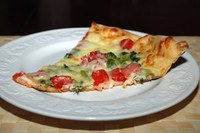Prairie Fare: October is National Pizza Month
(Click an image below to view a high-resolution image that can be downloaded)
By Julie Garden-Robinson, Food and Nutrition Specialist
NDSU Extension Service
Do you recall your first experience with pizza?
The first time I tried pizza, at about age 5, I was not sold on it. In fact, I couldn’t imagine why anyone wanted to eat it on a regular basis.
I was enticed by TV ads that said pizza made from the kit being advertised was “scrumptious.” I wasn’t exactly sure what that word meant, but I figured that meant it was pretty good.
Making a pizza at home supposedly was easier than going out for pizza. The nearest pizza restaurant was about an hour away from my home, so making a pizza at home definitely was easier than a two-hour round trip. I wasn’t a child during the time of covered wagons or Model T’s, by the way.
I asked my mom to buy a pizza kit and she agreed. I eagerly opened the pizza kit box at home. It contained a crust mix, a can of tomato sauce, an envelope of spices and a packet of Parmesan cheese.
We made it just as the package directed, and I helped mix the crust, which had a nice yeasty aroma. I spread the can of sauce on the crust. We didn’t add any “optional ingredients” such as mozzarella cheese or other toppings.
Imagine a pizza without stringy cheese, just a lot of tomato sauce on a soggy crust with a sprinkle of oregano, basil and Parmesan cheese. I ate a piece and didn’t ask for another pizza kit. However, later I changed my mind about pizza.
Now I live fairly close to several restaurants that serve pizza. Plus, making personalized homemade pizzas with a buffet of toppings is our family’s New Year’s Eve tradition. I always have plenty of mozzarella cheese and lots of veggies and protein options, not just sauce and herbs.
October is designated as National Pizza Month, but for many families, every month is pizza month. According to a website that collects pizza statistics (http://pizza.com), we munch our way through 3 billion pizzas every year in the U.S. In fact, 94 percent of households have pizza at least once a month. This equates to 45 slices of pizza for every person in the U.S. every year.
In the next months, we are approaching a few of the biggest pizza-eating times of the year: Halloween, the evening before Thanksgiving and New Year’s Day. We have many options to create our own pizzas at home, including premade crusts and freezer cases full of all sorts of pizzas.
Pizza sometimes is viewed as unhealthy or even as “junk food,” but well-chosen toppings can make your pizza a healthful menu option. Pizza can vary greatly in the number of calories per slice, depending on the toppings chosen and type of crust, so ask if your favorite restaurant provides nutrition information online or at the store.
Try creating personalized pizzas with each of the food groups represented and a range of topping choices. Here are some steps to making a pizza at home:
- Start with a whole-grain crust. We are advised to make half of our grain choices whole grains to get the benefits of fiber and a range of vitamins and minerals.
- Add a sauce. Tomato-based pizza sauce is an obvious choice, but we have many other options. Spread the crust lightly with hummus (seasoned chickpea dip), barbecue sauce, Alfredo sauce, Asian peanut sauce, salsa or pesto (made up of basil, olive oil and other ingredients) for a flavor change.
- Add some veggies, such as diced onion; sliced mushrooms; spinach leaves; diced red, yellow and green peppers; shredded carrots; diced tomatoes; or artichoke hearts.
- Try some fruit on your pizza. Add some sweetness with thinly sliced apples or pears or chunks of pineapple.
- Add some protein, such as sliced grilled chicken, black or white beans, shredded pork, cooked and drained ground beef or Italian sausage, shrimp or your other favorites.
- Don’t forget the cheese. Besides mozzarella and cheddar, consider adding some other flavorful cheeses, such as a little feta or Swiss cheese. You might want to sprinkle on some Parmesan, too.
Be sure to bake pizza in a hot oven at 450 F or above. Go light on the sauce to avoid a soggy crust. Adjust your baking time, depending on the number of toppings. Consider baking your pizza on a grill to impart a smoky, grilled flavor.
Here’s a pizza crust recipe from the North Dakota Wheat Commission (http://www.ndwheat.com) ready to inspire your creative choice of toppings.
Whole-wheat Pizza Crust
2 tsp. active dry yeast
3/4 c. warm water (105 to 115 F)
1 c. whole-wheat flour
3/4 c. bread flour (For best results, use part bread flour and part whole-wheat flour.)
1/2 tsp. salt
1 Tbsp. olive oil
In a medium bowl, dissolve yeast in water. Stir in both types of flour and salt. Add oil and mix. Turn out on a floured surface and knead about five minutes or until smooth and elastic. Place dough in a greased bowl, turning dough to coat the top. Cover and let rise in a warm place about one hour, until doubled in size. Punch down and let rest 10 minutes.
On a floured surface, roll dough into a large rectangle for a thin-crust pizza or to fit a 12- or 14-inch pizza pan for a thicker crust. Place on a baking sheet or pizza pan sprinkled with cornmeal. Pinch edges to form a lip. Top with your favorite sauce, veggies, meat and cheese. Drizzle with olive oil. Bake in a preheated 450 F oven for about 15 minutes. The baking time will vary, depending on the thickness of the crust and the toppings.
Makes eight servings of crust. Each serving has 110 calories, 2.5 grams (g), 4 g protein, 18 g carbohydrate, 2 g fiber and 150 milligrams sodium.
(Julie Garden-Robinson, Ph.D., R.D., L.R.D., is a North Dakota State University Extension Service food and nutrition specialist and professor in the Department of Health, Nutrition and Exercise Sciences. Follow her on Twitter @jgardenrobinson)
NDSU Agriculture Communication - Oct. 12, 2017
| Source: | Julie Garden-Robinson, 701-231-7187, julie.garden-robinson@ndsu.edu |
|---|---|
| Editor: | Ellen Crawford, 701-231-5391, ellen.crawford@ndsu.edu |



